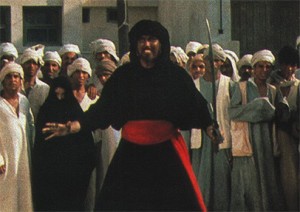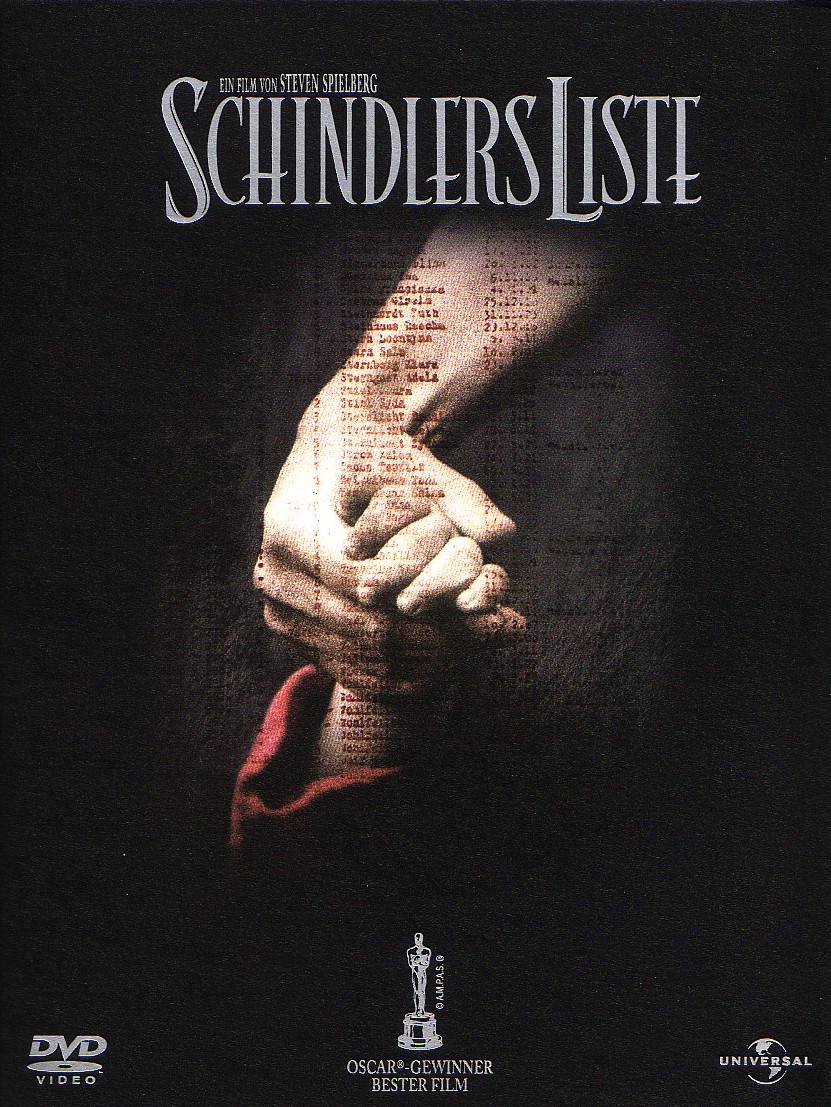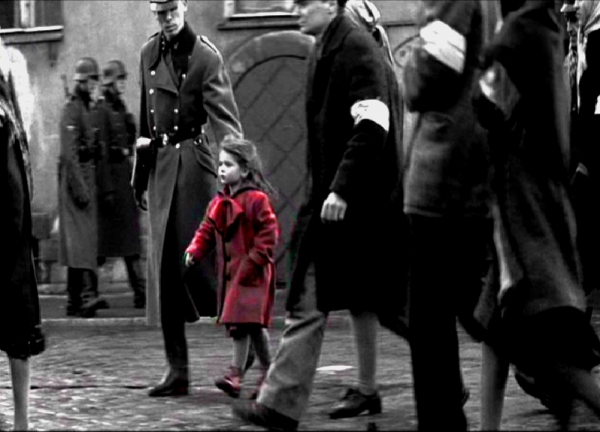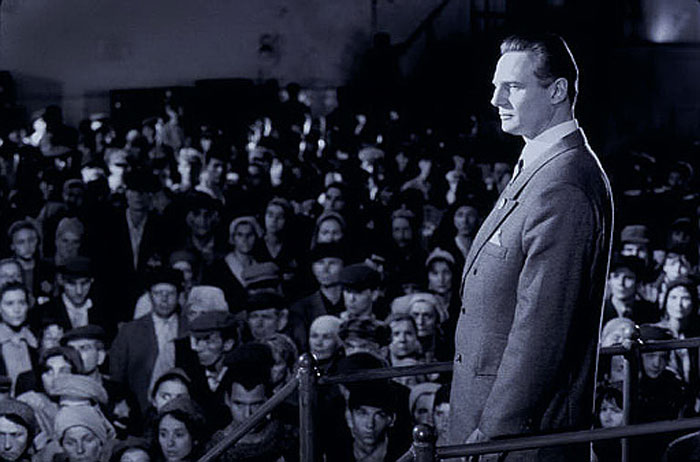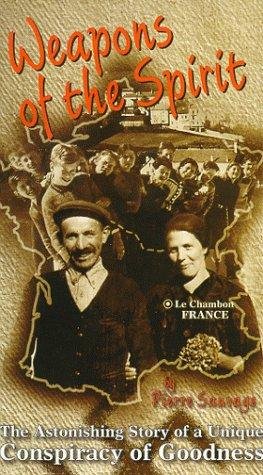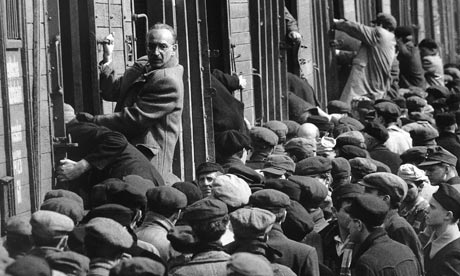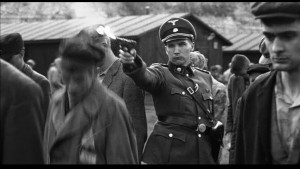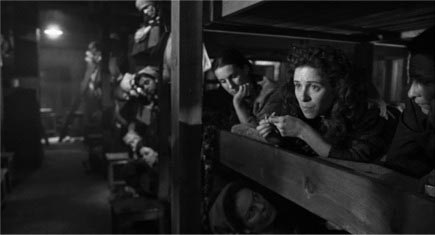From the Chicago Reader (December 17, 1993), also reprinted in my collection Movies as Politics. — J.R.
SCHINDLER’S LIST
*** (A must-see)
Directed by Steven Spielberg
Written by Steven Zaillian
With Liam Neeson, Ben Kingsley, Ralph Fiennes, Caroline Goodall, Jonathan Sagalle, and Embeth Davidtz.
The ideological structures of Spielberg’s films “hail” the spectator into a world of the obvious that affirms the viewer’s presence (even while dissolving it), affirms that what the viewer has always believed or hoped is (obviously) right and accessible, and assures the viewer excitement and comfort in the process. The films offer nothing new beyond their spectacle, nothing the viewer does not already want, does not immediately accept. That is their conservative power, and it has spread throughout the cinema of the 80s. — Robert Phillip Kolker, A Cinema of Loneliness (1988)
Confessions are in order. From Duel to Jurassic Park, there are few Steven Spielberg movies I admire, and none I fully respect — though I respond to a good many of them as obediently as any well-oiled automaton. My first look at Close Encounters of the Third Kind actually brought tears to my eyes. I can’t say that on reflection I felt much pride in this response, though the experience of becoming a boy again in relation to the imagined parental benevolence of the cosmos — which also happens with Ray Bradbury’s best early tales about Mars — may be morally preferable to feeding on the murderous xenophobia of Star Wars, released the same year (1977); at worst one winds up feeling silly rather than dirty afterward. But the long-term gains from either vision are questionable. And once Spielberg joined the Lucas camp with the Indiana Jones cycle — combining the ruthless efficiency of Jaws with the colonialist fervor of Star Wars — my misgivings about the power of his work only escalated. If the euphoria Orson Welles conveys about filmmaking in Citizen Kane can be summed up in the line “I think it would be fun to run a newspaper,” the euphoria Spielberg conveys about filmmaking in Raiders of the Lost Ark, expressed in its most effective action moment, could just as aptly be summed up by the thought “I think it would be fun to shoot an Arab.” Indeed, while Spielberg has not yet given us a Beavis and Butt-head in the Persian Gulf, I have every expectation that if or when such a movie comes along, the imprimatur of his divine inspiration will be stamped onto every frame.
Perhaps due to my many years of living abroad and not eating the proper number of hamburgers, the suburban spirituality of E.T. left me relatively untouched. I was more impressed by the virtuosity of 1941, a picture whose honest mean-spiritedness and teenage irreverence — both partially the contribution of cowriter Robert Zemeckis — struck me as closer to Spielberg’s soul, even if the picture wound up losing money. By contrast, The Color Purple and Empire of the Sun were both grotesque Oscar bids — strained subliterary attempts to make reparations for the genocidal glee of the Indiana Jones romps by expensively dry-cleaning the work of distinguished authors — and I had every expectation that Schindler’s List would complete Spielberg’s dubious trilogy of good intentions.
Up to a point, these expectations were fulfilled. But candor compels me to admit that Schindler’s List not only made me blubber helplessly both times I saw it, once before and once after reading Thomas Keneally’s fascinating nonfiction novel; it has also, though I have some misgivings, won my gratitude and respect.
A small but significant part of my reaction can probably be traced to personal factors: as the grandson of Polish Jews, I am one of those who might have been saved (or not saved) from the gas ovens by Oskar Schindler if my father’s father hadn’t immigrated to the States when he was eight. My grandfather, a self-made businessman, also resembled the non-Jewish Schindler in certain respects — he was a hedonistic bon vivant whose successful business tactics, including bribery when it seemed necessary, filled him with such guilt that he became a leading philanthropist in the same community where he made his fortune.
But while these facts undoubtedly colored my experience of Schindler’s List, they don’t account for why I think it qualifies as Spielberg’s best film, as well as the first one really worth quarreling with. Just for starters, I can think of four reasons to praise it:
(1) The beauty and density of Janusz Kaminski’s black-and-white cinematography, ranging from exquisite high-contrast night scenes to richly textured deep-focus long shots to grayish hand-held documentary-style footage. It far surpasses the look of any other new American feature I’ve seen this year and reminds me once again how the idiotic commercial requirement of color in Hollywood movies — usually blamed on the tastes of brain-dead teenage viewers (who don’t know any better) rather than on gutless producers and other movie executives (who should) — steadily deprives us of both visual pleasure and verisimilitude. I know that “life is in color” is supposed to shoot down every argument on behalf of the verisimilitude of black and white, but the fact remains that the colors in the life I know have scant relation to the colors I usually see in commercial movies; and the failure (both artistic and technical) of most directors and cinematographers to control color meaningfully has turned good contemporary black-and-white cinematography into even more of an aesthetic luxury. Alas, Spielberg’s expressed justification for using it — “Virtually everything I’ve seen on the Holocaust is in black and white” — is the lamest reason I can think of, denying any motive beyond an obeisance to dubious popular cliches about the past versus the present. But fortunately Kaminski’s work shows us countless better reasons for what he and Spielberg have done.
(2) Spielberg’s power as a storyteller. The film runs for 185 minutes, and none of it drags or stalls. Very little of it fragments into show-offy set pieces or sequences destined for Premiere magazine’s “Shot by Shot” feature, the standard bane of this sort of Oscar-mongering. The most important exception to this is a fancy montage sequence intercutting a Jewish wedding in a labor camp, the camp director harassing and then beating his Jewish maid in his wine cellar, and Schindler cavorting at a nightclub — a sequence that is on all counts the worst thing in the film. Otherwise, the script, credited to Steven Zaillian (most recently the writer-director of the first-rate Searching for Bobby Fischer), is generally a model of exposition and pacing. If it leads to certain questions about the ideological implications of Spielberg’s method — implications already suggested in the quotation by Robert Phillip Kolker at the head of this review — it can’t be faulted for its craft.
(3) The performances. Liam Neeson as Oskar Schindler and Ben Kingsley as Itzhak Stern, Schindler’s Jewish accountant and right-hand man, are both indelible portraits, and as good as any work I’ve seen from either actor. I’m somewhat less happy with the characterization of Amon Goeth, the camp director, but the performance of British stage actor Ralph Fiennes in the part is good (in fact, I suspect Fiennes may wind up with the most prizes). And the work of countless other actors, mainly Eastern Europeans, is no less accomplished.
(4) The film’s success at conveying some of the enormity of the Holocaust, as well as some of its banal details, in a fully accessible manner, at a time when much of our collective memory and understanding of it is rapidly slipping away. Much of the time it accomplishes this less through graphic portrayals than through appeals to our imaginations. Another film that took on this task and performed it more responsibly and comprehensively — if less accessibly — is Claude Lanzmann’s Shoah (1985). But Shoah [see above photo] is a documentary and explicitly a Jewish film, and with an eight-hour running time to boot it clearly can’t address as wide an audience. Despite both the subject matter and the fact that Spielberg himself is Jewish, Schindler’s List is anything but a Jewish film. Indeed, as I hope to show, even Jews who see this film are implicitly transformed by the narrative structure into gentile viewers.
Although the book is technically a novel, Keneally’s author’s note states, “I have attempted . . . to avoid all fiction, since fiction would debase the record, and to distinguish between reality and the myths which are likely to attach themselves to a man of [Oskar Schindler’s] stature.” Though the same claim can’t be made for the film — Spielberg’s desire to dramatize appears to exceed Keneally’s need to fictionalize — it’s worth stressing that with a few notable exceptions everything in the film can be traced in some form back to the book, which is itself based on detailed research, including interviews with more than two dozen participants in (and witnesses to) the events described. Thus many of the film’s oddest departures — such as the use of color to highlight the red overcoat of a little girl in an otherwise black-and-white crowd during the evacuation of the Krakow ghetto — find their basis in Keneally’s narrative even when the reason for them has been obscured or elided.
Oskar Schindler — born in 1908 in Moravia, a province in the Austrian empire that later became part of Czechoslovakia, and raised as a Catholic — was a Nazi war profiteer who earned most of his wealth by employing Jews in an enamel-cookware factory in Krakow, Poland. He hired his workers in 1939, shortly after the beginning of the German occupation, when Jews from all over Poland were already being forcibly relocated to the Krakow ghetto.
A well-dressed partygoer and womanizer who excelled in bribery and black-market deals, Schindler hired Jewish accountant Itzhak Stern to help run his plant and later managed to set up a second plant on the grounds of a forced labor camp near Krakow after his Jewish workers were relocated there. Then, when the camp was about to be shut down, with all its residents slated for extermination in Auschwitz, he wound up saving the lives of more than 1,100 Jews by effectively buying them from Nazi officials and shipping them to an ersatz munitions plant in his hometown, where he protected and supported them until the end of the war, spending the remainder of his fortune in the process. After the war his various business enterprises were all failures, and he was sustained until his death in 1974 by some of the Jews he saved, who called themselves Schindlerjuden, or “Schindler’s Jews.” At his own request, he was buried in Jerusalem; though the film, which concludes with a color documentary sequence at his grave site, neglects to say so, his final resting place is in a Catholic cemetery.
Spielberg’s film — which functions in part as a fanciful and idealistic self-portrait (more about this later) — is patriarchal to the core, even when this means tampering with some of the facts. While it’s true that Schindler resumed living with his long-estranged wife Emilie when he established his mock munitions plant in Moravia, the film shows him pledging sexual loyalty to her — during a church service, no less — just after he arrives there. In the book there is every indication that his sexual carousing continued as before, which makes for a more intriguing story that Spielberg chooses to ignore; two of the Schindlerjuden told Keneally about finding Schindler one day skinny-dipping with a voluptuous blond SS woman in a water tank inside the factory.
Emilie’s tireless efforts in helping the Schindlerjuden in Moravia — which Keneally attributes to her strong religious convictions as well as her loyalty to her relatively unreligious husband — also get short shrift in the movie. As Spielberg recounts the story, this is Schindler’s show all the way, with only poker-faced Stern posited as a worthy crony and accomplice. The extraordinary tale of collective resistance told in Pierre Sauvage’s 1989 documentary Weapons of the Spirit — about the 5,000 inhabitants of Le Chambon, France, most of them Huguenots, who managed to shelter 5,000 Jews during the Nazi occupation, only 20 miles from Vichy — is in some ways even more remarkable than Schindler’s unselfish feat, because many more people were involved in the effort, Christians and Jews alike. But Spielberg’s interest is generally in lone, charismatic father figures like E.T. and Schindler. If the term “Schindler’s Jews” irresistibly calls to mind the telethon catchphrase “Jerry’s kids,” the notion of the single male parent is operative in both cases; and in this case the single male parent is gentile. One might add that to the same degree that the saved Jews became “Oskar’s kids,” we, as viewers, become Steven’s.
Another omission relates to the final compiling of the list of Jews Schindler is to take out of Poland with him. In the film, this is accomplished exclusively by Schindler and Stern; in reality, a personnel clerk named Marcel Goldberg — a character who’s present only in passing in the film–put the finishing touches on the list, accepting diamonds as bribes from some families in exchange for their inclusion and excluding others when they couldn’t cough up the necessary loot. Keneally plausibly absolves Schindler — who was busy at the time pulling strings elsewhere–from any direct blame in this matter, but it’s symptomatic of the movie’s tactics to omit such disturbing details in order to avoid the resulting moral complications. In the final analysis, Spielberg wants to show Schindler’s goodness as the ultimate defense of capitalism, just as Nazism and the Holocaust itself are viewed as the ultimate perversions of capitalism — horrors requiring only a Schindler to set things right again. Including Goldberg on Schindler’s side of the fence would only confuse this mythology.
A more general difference between the book and the film relates to our understanding of Schindler’s personality. In the book he remains a genuine enigma — the sum of sometimes conflicting and often speculative accounts of the people who knew him. Spielberg, whose sense of drama won’t tolerate such uncertainty, sees this strictly as a conversion story — a Nazi meanie who becomes a saint — even though the implied conversion takes place offscreen. It’s an easier story to tell, but ultimately less interesting and less believable than what actually happened. (Not all of Keneally’s most hair-raising anecdotes are in the movie; I hope that many people who like the movie will be led to the book by it, as I was.)
The character of Amon Goeth, the Nazi director of the forced labor camp and the main villain in book and movie alike, is likewise simplified — played by Fiennes as a classically foppish German decadent with Caligula-like flourishes. While Spielberg takes much of this character’s monstrous behavior — such as his shooting of Jews arbitrarily or for minor offenses — straight from the book, he chooses to minimize Goeth’s growing obesity. And while he takes the trouble of flashing forward to show him being hung in 1946, he omits entirely an unforgettable scene from the book in which Goeth, now lean and diabetic, having been imprisoned and then released by the Nazis for his aberrant behavior, visits Schindler’s factory in Moravia a defeated man.
Keeping Goeth slim and glamorous seems central to Spielberg’s overall narrative strategy. The point isn’t merely to make his villain more theatrical (as it is when, in one of the film’s corniest conceits, he has another Nazi officer playing Mozart on a piano in a ghetto flat while his colleagues are busy machine-gunning Jews). The main idea is to assist us in identifying with Nazis — not with their cruelty, which we’re supposed to recoil from, but with their privileged vantage point, their power and preeminence (Goeth is not unlike a studio head). Schindler himself, as Goeth’s friend and confidant, the saintly businessman who even manages to dream up a scheme for curbing Goeth’s murderous impulses, serves as the expedient emissary of this process (not unlike a film director). Thanks to him we have the vicarious thrill of attending Nazi parties and enjoying the lush revelry in Nazi nightclubs (both rendered in some of the film’s silkiest, most gorgeous high-contrast black-and-white images), looking down at the Jewish prisoners from the balcony of Goeth’s chateau (perched on a hill high above the camp), savoring the luxury of Schindler’s new Krakow flat (freshly evacuated by a once-wealthy Jewish family forced to move into a ghetto hovel), and so on.
On a few special occasions, the film also asks us to identify with the Jewish victims — again as gentile viewers, using Schindler’s humane sympathy as our guide. On these occasions the shots generally become newsreel-gray and hand-held, and the language we hear often switches from English to guttural European tongues, increasing our terror with both a sense of actuality and a sense of the unknown. But more often we’re asked to sit with Schindler or Goeth in the catbird seat. That’s why, when Goeth sadistically flirts with, interrogates, and finally beats his abused Jewish maid (Embeth Davidtz) in the wine cellar where she usually hides from him, Spielberg takes care to show us Davidtz’s nipples through the slip she’s wearing — to ask us to share Goeth’s unresolved sexual attraction to her.
It might be inferred from the above that I’m only denouncing Spielberg’s tactics. But the fact remains that if he weren’t this ruthless or this efficient I wouldn’t have wept at the end of Schindler’s List both times I saw it. And as tempting as it is to ridicule Spielberg’s reasons for making it — which probably include a narcissistically far-fetched identification with Schindler, and may even, for all I know, incorporate George Bush’s evocation of a “kinder, gentler” America — it would be stupid to deny that art often grows out of just such contradictions.
It’s virtually axiomatic that to make a big-budget commercial movie with a moral purpose behind it these days, something immoral in the viewer has to be not only assumed but addressed — and maybe even cultivated. The forthcoming Philadelphia, about a gay lawyer, is essentially addressed to homophobes. Likewise, Schindler’s List assumes a desire to identify with the class in power; it can only tell us what it has to say about Schindler by turning us into Schindler — which also means turning us into a Nazi.
For all Spielberg’s efforts to account for Schindler’s actions by describing his growth as a spiritual conversion, the mystery of the man and what he managed to do stubbornly remains. And when Schindler weeps for not having been able to do more — a scene that this movie has the brass to invent out of whole cloth — I’m ready to weep with him.



